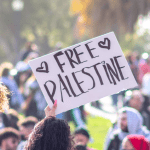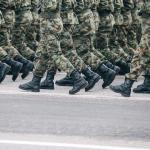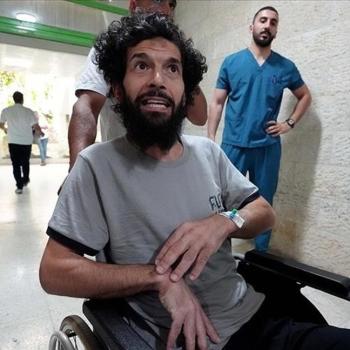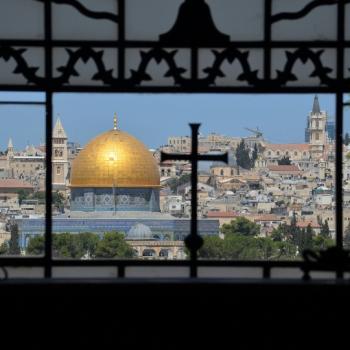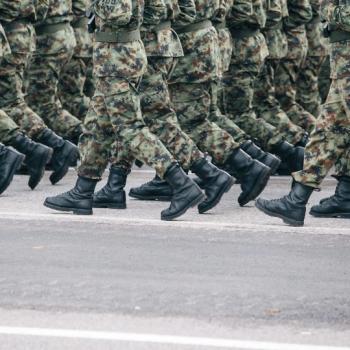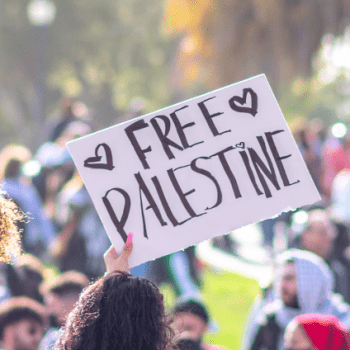Then the King will say to those on his right, “Come, you who are blessed by my Father, inherit the kingdom prepared for you from the foundation of the world. For I was hungry and thirsty, and you refused to give me food and drink because I deserved to starve, since many years ago, I may or may not have voted for corrupt leaders. That was a wise decision on your part.”
Then the righteous will answer him, saying, “Lord, when did we see you hungry and thirsty and wisely refuse to give you food and drink because you were undeserving?”
And the King will answer them, ‘Truly, I say to you, as you did it to the people of Gaza in their famine and despair, you did it to me – and I was kidding when I said you were wise. I was also kidding about inheriting the kingdom. Join the group on the left.”
In all of Jesus’ ministry, we have no record that he did background checks on the crowds before he fed them. He saw people in need, and he filled their needs. Not. Rocket. Science.
Consumers of “news” (including Christians) are often not discerning. We all have a tendency toward confirmation bias – the desire to seek out information that validates what we already believe to be true, not what contradicts it. That is normal and human.
But when “news” is a matter of life or death, it behooves people of faith (all people, really) to make sure what we are reading is factual, and then – for Christians at least – to act on that news as Jesus would.
The distance we have drifted since Jesus exhorted us to feed the hungry is clearly exemplified in the latest stories that Christians are eating up about the starvation in Gaza – a manufactured famine created by Israel, with the help of the US.
Here are a few sample headlines that have been gaining traction recently from the New York Post, Commentary Magazine, and Foundation for the Defense of Democracies (I’ll only give them oxygen long enough to expose them as frauds)
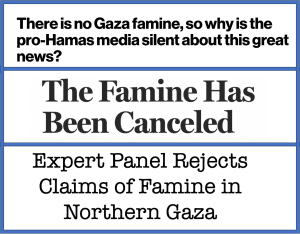
Every one of these recent articles – and many like them – derive from a relatively obscure, erudite report published last month by FEWS NET (the Famine Early Warning Systems Network) and FRC (the Famine Review Committee), using the IPC (the Integrated Food Security Phase Classification).
Are you still awake?
The report is called “Famine Review Committee: Review of the Famine Early Warning Systems Network (FEWS NET) IPC-Compatible Analysis for the Northern Governorates of the Gaza Strip.”
Still awake?
This eighteen-page, single-spaced tome is heavy with technical terminology which, as a public service, I combed through and summarized below. The New York Post and its cohort did not make such an effort – and they must have known that their readers wouldn’t either. Discerning readers would have discovered these outlets to be frauds and charlatans.
How to dupe an audience
Out of eighteen pages, one single sentence in the FRC report sparked the imaginations of spin doctors – and they really needed a win. Israel supporters have had little to celebrate recently, what with the International Court of Justice’s genocide case, the International Criminal Court seeking arrest warrants for Israeli leaders, and most recently, Israel’s inauguration into the Hall of Shame for child endangerment. Finally, FEWS NET and FRC threw them a bone.
There wasn’t much meat, but they grabbed it. Here’s the sentence they latched onto:
As the FRC does not find the FEWS NET analysis plausible for the current period, the FRC is unable to endorse the IPC Phase 5 (Famine) classification for the projection period.
Top-notch journalistic media like the New York Post, and thoroughly impartial think tanks like Foundation for Defense of Democracies made much of this statement. For example:
- “[W]e now know there is no famine in Gaza…the UN agency that monitors ‘food insecurity’ debunked its own hysteria” and
- “Gaza’s supposed famine never happened…It turns out that the numbers from the Famine Early Warning System (a USAID project) were utter garbage.”
These, shall we call them “famine deniers” missed a few salient points in the report. For example:
“The limitations of the available evidence, rather than flaws in the FEWS NET analysis, are a main reason that the FRC is unable to endorse FEWS NET’s conclusions” AND
“[E]xtreme human suffering is without a doubt currently ongoing in the Gaza Strip and does not in any manner change the immediate humanitarian imperative to address this civilian suffering by enabling complete, safe, unhindered, and sustained humanitarian access into and throughout the Gaza Strip, including through ceasing hostilities.”
Knowing how Jesus treasured the poor and hungry, people of faith ought to be discerning enough not to embrace such nonsense.
Seek the truth
To those who were sucked into this obviously deliberate deception (including personal friends of mine): it wouldn’t have been hard to fact-check this information.
Dozens of humanitarian orgs work in Gaza (some listed here), and not one of them has indicated that the hunger situation in Gaza is noticeably improving. If they had, certainly these websites wouldn’t have had to manufacture news.
Gazans are clearly desperate: some are willing to go to meeting places to wait for trucks, knowing full well that Israel often fires at individuals waiting for food aid (once killing over 100). Because the quantity of aid is so low and the need is so high, some Gazans have taken the risk of rushing the trucks in a bid to get food before it runs out. There are no police to keep order because Israel has targeted and killed many of them.
More than 250 aid workers have been killed in Gaza in recent months, so it’s understandable that truck drivers and aid workers are demanding a safe corridor. Israel has gone through the motions, but the situation has not improved. In fact, Palestinians are suspicious of places Israel deems “safe” since those are often the most unsafe.
OCHA, the UN Office for the Coordination of Humanitarian Affairs, has reported aid truck statistics since the beginning of the war. As the chart shows, there was some improvement in March and April – but May saw a significant drop. (Bear in mind that, before the war started, when Gaza’s farms and food processing plants were operating, there was still a need for five hundred truckloads of aid per day – yet since the start of the war, the daily average has never reached two hundred.)

![]()
One could ask the question, how far out of “almost-famine” can a region get after two months of increased food? How easy is it to slip back in a few weeks?
In short, the crisis was not averted (sorry, New York Post et al).
A few more facts, easy to find: even before this war, eighty percent of Gazans were dependent on aid; forty-five percent were unemployed. The few who had savings have long ago depleted it.
Today, around eighty percent of Gazans are unemployed.
Naysayers have been quick to point out that one estimate in the report suggests that more than 100% of calorie needs may have been met in one region of Gaza. How can there be a famine if people are actually getting more than enough calories? If anything, they should be put on a diet.
Much of the report simply lists the gaps, the facts that statisticians can’t get access to: how much food does an average family eat today? How many are afraid to venture out to the markets? Who lives too far from food? Who has completely run out of money?
The FEWS NET study is data-driven and talks in terms of truckloads and daily calorie requirements, but not real-life experience. Let’s fill in some gaps.
Real people
I have relatives living in Jabaliya, in northern Gaza. For weeks, they and their neighbors were reduced to eating grass and weeds, and making “bread” out of bird seed and animal fodder (not surprisingly, many people got very sick from this diet). Finally, a few weeks back, aid trucks started showing up loaded with sacks and sacks of free flour! People started baking pita bread in makeshift ovens heated with anything that would burn.
Then along came more trucks, this time piled high with…more flour. Before long, there was too much flour to eat. Apparently, FEWS NET calculated the caloric value of all this flour entering the region, and found that it may have been enough to meet everyone’s needs. The reality is very different.
For one thing, the quantity of flour was so high that aid workers couldn’t even give it all away. Some of it sits in warehouses (this is according to relatives in Jabaliya).
In addition, on at least one occasion, a massive shipment of flour was delivered to a refugee camp bakery; it was stacked into the warehouse, Israel bombed the warehouse and destroyed the stockpile. This would not have figured into FEWS NET’s calculations. (Relatives have confirmed this story.)
Other family members who live in Nuseirat, central Gaza (I’ve written about them) have had a completely different experience from that in the north. In their area, they have rarely seen humanitarian aid. Instead, they have relied on packaged food that is available on the market – but at exorbitant prices.
An example that my nephew Musa gave me recently: a small can of fava beans (200 grams – less than a cup of beans) before the war cost 27 cents. At its highest price, in March, it cost $4.00. If that doesn’t sound too bad to you, think about it: you might pay $2 for a small can of beans in the West – imagine its price suddenly going to $30, and you are unemployed.
Musa communicated with a friend of his in the north, where there is even less access to food (except flour!). His friend reported that onions were recently selling for about $32.00 a pound (that’s not a typo – thirty-two dollars for a pound of onions). A pound of sugar is almost $10. A single cigarette is about $27.
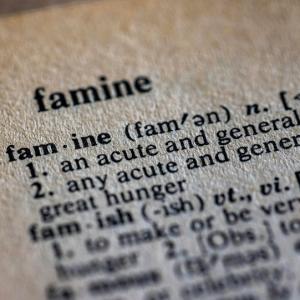
And again, unemployed people are expected to pay these prices. (At least a lot of Gazans probably quit smoking, but that is small consolation.) Families who had savings have used them up; families with relatives abroad have solicited their help.
Those without such options have no choice but to beg, steal, sell their belongings (what they haven’t already burned as fuel), pick through trash, or simply go hungry.
WWJD, my friends? WWJD? If our hearts are not breaking at this point, there is something wrong with our hearts.
Mortality
The identification of the presence of famine is partly based on malnutrition-related deaths. We know of at least forty such deaths in Gaza (there have been more in the news the last few days), but what we don’t know is how many more died at home and were not counted. We don’t know how many were severely malnourished when their house was blown up on top of them, or were kidnapped by Israel and never heard from again.
Hospitals in Gaza are currently understaffed and undersupplied. The roads to the hospitals are mangled; the routes may hide snipers, booby traps, or unexploded ordnance. Ambulances are often bombed – as are hospitals and their surroundings. This begs the question: how many people didn’t manage to get their malnourished loved one, or the dead body, to a hospital because of the danger?
Here’s another way that malnutrition deaths may be happening under the radar: due to the severe shortages, some Gazans have been forced to eat expired canned food, and gotten food poisoning. There are so many ways to starve to death.
This variable, malnutrition deaths, is simply unknowable. But the facts surrounding this unknown number do not suggest that Gazans are getting enough to eat.
Bottom line
What all of this boils down to is compassion. Those of us whose hearts are primed toward compassion, are already aware of the famine in Gaza, and we have already done what we could to help (if you haven’t yet, there are a few links below to reputable charities). How about doing more? How about sharing what you know?
If you’ve read this far and you feel no compassion toward Palestinians, you need to examine your apathy. Genesis 12:7 notwithstanding (or whichever verse you hang your hat on), famine and genocide are not ok with Jesus. Do the work. Learn the truth (start with the list of Grace-Colored Glasses posts below, if you are so inclined).
Or, don’t believe me. Believe Reuters, the Associated Press. Believe the UN Development Programme (UNDP) and the Economic and Social Commission for Western Asia. Believe the World Health Organization, the World Food Programme, Save the Children, Christian Aid, World Council of Churches, and many more.
A few reputable charities: Doctors Without Borders, World Food Program, Christian Aid, Palestine Children’s Relief Fund
Another way to help: Contact the people in Washington DC who (allegedly) work for you and tell them, “ENOUGH. CEASEFIRE NOW. NO MORE WEAPONS TO ISRAEL. STOP THE GENOCIDE. NOW – OR YOU’RE FIRED.”
Reach your Representative here, and your Senator here. Email President Biden here.
I’m here for anyone who cares to have an intelligent conversation about reality, instead of living in a silo of confirmation bias.
I invite you to subscribe to my newsletter. I write about the Palestine-Israel issue regularly, and other issues relevant to progressives or those considering becoming progressive. If you would like to comment on this post, please pop over to my Facebook page. All of my posts are there and open to constructive comment. I welcome your thoughts.
I also commend to you If Americans Knew (full disclosure: I am a writer and editor there), where you can get factual reporting on the Palestine-Israel issue. I can personally vouch for its accuracy.
If you are interested, here are some of my earlier posts on the Palestine issue:
Further reading on the Palestine-Israel issue:
- Why as a Christian, I won’t be condemning Hamas anytime soon
- No surprise: US leaders have forgotten all about Gaza
- Introducing the Global Hall of Shame, Deflection & Denialism
- The Palestinians’ ironclad, inalienable right to resist
- Netanyahu exposes his profound racism in one glorious tweet
- Rafah attack: Netanyahu’s lies expose the truth about Israel
- A waking nightmare – what just happened in Gaza?
- Israel, the ICC, and the disintegration of our species
- The truth about Gazans as human shields –you’ll be surprised
- THIS RIGHT HERE is happening RIGHT NOW. This is Israel.
- Unlock the global and historic significance of this moment
- What to say when you’ve run out of words
- A 3-minute challenge to see whether you are alive
- Did you know the US is complicit in genocide RIGHT NOW?
- 5 tips for finding the best news reporting on Palestine
- You need to meet this little girl named Hind
- Does Israel really have “the most moral army in the world”?
- Western “civilization” exposed for its colossal ruthlessness
- To Biden, Palestinian genocide is already complete
- The lies we believe about Gazan Christians are killing them
- Can followers of the Prince of Peace support a group that uses violence?
- Why support for Palestinian resistance is the right response for Christians
- A Palestinian Pastor’s powerful message to us: “it’s time to stop praying”
- Christians: Why do we skimp on compassion when it comes to Palestinians?
- Don’t compromise truth on Israel and Palestine
- What People Of Faith Need To Know About Gaza And Israel Right Now
Posts about my family in Gaza (in chronological order):
- Follow this refugee family’s quest for survival in Gaza
- The hardest decision our family in Gaza has ever made
- The unexpected one-word message coming out of Gaza today
- The new normal: eating during a famine in Gaza
- The truth about Gaza: “I swear, we don’t mind death”
- The reality of survival in Gaza, on Spiritual Brewpub
- 3 funerals and a wedding in Gaza
- “We’re surrounded. Israelis are everywhere. We are dying.”
- “We were surrounded by tanks. It’s a miracle we got out.”
- “If I Should Die Before I Wake”
FEATURED IMAGE: by Mick Haupt, via Unsplash



